All Blacks v France
-
@Billy-Webb Most probably. Apologies @Billy-Tell. I got my Billys mixed up

-
@stodders said in All Blacks v France:
@Billy-Webb Most probably. Apologies @Billy-Tell. I got my Billys mixed up

To tell the truth you’re sort of correct. My dad was South African but moved to NZ in the 1970s where he met my kiwi mum. At that period, when you became kiwi you had to relinquish SA citizenship which my dad did (willingly). He considers himself a kiwi through and through and has lived more of his life in NZ than SA. As for me Kiwi + Swiss (through marriage). But yeah billy Webb. That guy can’t use a crossbow to save himself.
-
When Jason Holland was confirmed as backs coach at the end of 2023, I wasn’t quite as disheartened as many seemingly were on this forum, a feeling especially common amongst Hurricanes fans. While Holland had his considerable limits as head coach and selector at the capital-based franchise, there was one facet in which he and his Hurricanes teams excelled in, and that was set piece-attack. All things considered, that was pretty much the exact reason he was brought in for, as first Leon Macdonald and then Scott Hansen would take care of the broader principles of the attack. When Will Jordan was asked about his try against England ahead of the Dublin test, he was quick to redirect the plaudits to his backs coach for meticulously planning out the strike move: “It was good to connect with Beaudy and he put a great ball back to the inside, so. But the credit must go to Jase Holland who organizes our lineout strikes. [He] spotted an opportunity there and it paid dividends.”
So when France infringed in the 74th minute of Saturday’s Test match, the stage was set for a Hurricane strike move to finish the job. And yet, Scott Barrett went for three rather than a lineout attack, seemingly signalling a distrust in the efficacy of the strike moves. So what exactly has happened? In order to understand this moment a bit better, I’ve taken a look back at the Hurricanes’ set-piece attack under Holland, why it didn’t make an appearance at the end of the game against France and some of its teething issues in Test rugby.
The Hurricane lineout attack
Holland’s lineout attack at the Hurricanes was characterized by its simplicity, its efficacy and its potential for small but successful variations. Its most effective shape was marked by its use of a six-man lineout with a plus one in the boot, who functioned as the in-field passer to a running 9. The core principle of this move was to have multiple runners in motion, organized around an “arrow runner” (not quite sure what to name this, but arrow seemed appropriate) in midfield, with passing options off both shoulders as well as a further one (typically, the first five) out the back.A good example of both this signature strike move as well as a slight variation to it can be found in the Hurricanes match against the Rebels in Wellington, in Round 14 of Super Rugby Pacific 2022.
Highlight with timestamp
Early in the game, the Canes have a lineout just outside the Rebels 22. They call a six-man lineout formation, set-up to maul, with Kirifi as plus one. O’Reilly throws to Gibson at the front who quickly transfers to Kirifi, who passes to a running TJ Perenara. Perenara throws a cut-out pass to Proctor in the midfield (the arrow runner), with Love running a hard inside cut while Morgan loops around. Proctor throws the backdoor to Morgan after the Rebels’ midfield has bitten in on Love, creating a two-on-one, leaving Julian Savea with only one man to beat.
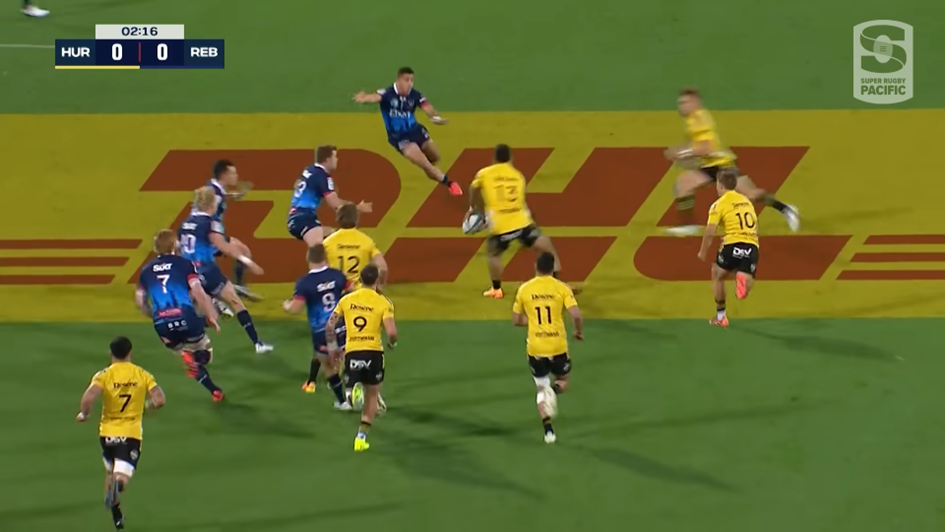
Vaihu has bitten in on Love, leaving Morgan free to create the overlapSeven minutes later, the Canes have another lineout, this time just inside the Rebels 22.
The Canes set up in the same formation and you can see how the Rebels midfield defender, Kellaway, identifies this. This time, he aims to shut down the overlap by targeting the out the back option (Morgan). The only problem is that the Hurricanes have gone for one of their slight variations: Perenara holds the ball a fraction longer, Proctor, the arrow runner, drifts to Kellaway’s inside shoulder and when the 9 passes, a gap has already been created through the Rebels’ midfield’s anticipation of the back-door option. They have taken their eyes off the arrow runner as a potential carrier, leaving the latter to simply run through the space and score the try. Simple but effective.
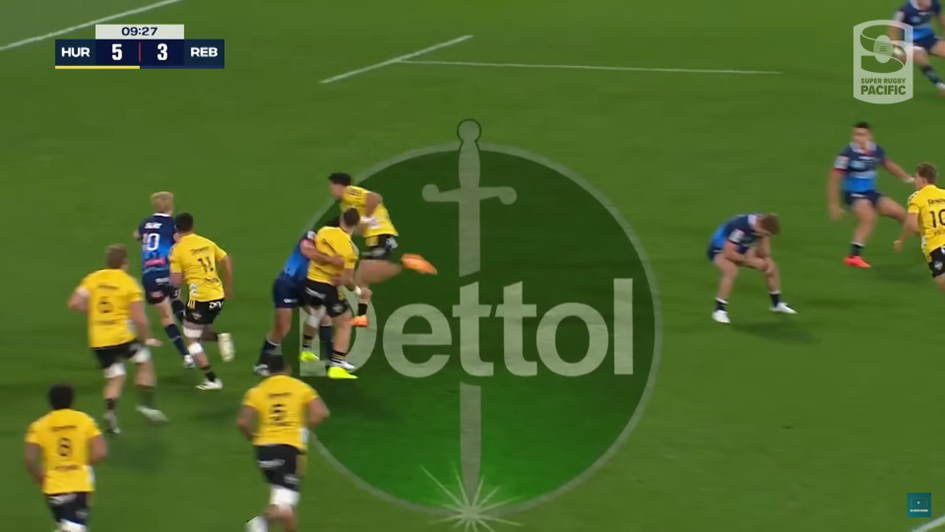
A visibly dejected Kellaway, after being burned again by the strike playThe six+1 lineout strike made regular appearances in the Hurricanes’ highlight reels across the Holland seasons. I’m sure it greatly enhanced Holland’s reputation as a set-piece specialist. It is also understandable how a portfolio like Holland’s would be attractive to someone like Scott Robertson. While Robertson is a firm believer in defence, counter-attack and set-piece pressure, set-piece attack, especially the lineout peel in the opposition 22, was a staple of the Crusaders during Razor’s tenure. It typically acted as a kind of secondary source of scoring income, an added platform for opposition pressure rather than the core game plan. The in-play superiority of the team would set the team up for victory, and the set-piece attack could act as the killer blow. While Hansen is Razor’s trusted companion, Holland seemed to be appointed to be his sword. So why was it so blunt against France?
Lineout attack at the Stade de France
At first, it seemed as if the Hurricane lineout strike would not get to make an appearance in the test match. Instead of the typical six-man lineout set-up, with the +1 in the boot to act as the in-field passer, the ABs went for five-man lineouts, with Roigard at the base to throw the in-field pass to Barrett at first receiver. Rather than set-up for any sort of immediate strike, the goal seemingly was to secure possession and settle into phase-play, with several passages of play after an NZ lineout going to 7+ phases. While these lineout attacks weren’t necessarily unsuccessful – apart from the botched Savea to Ioane transfer in midfield and the breakdown penalty – it ultimately resulted in very little on the scoreboard, New Zealand’s tries coming from good counter-attack on kick return and a forced turnover around the French 22.It was only in the 52nd minute, after France had just scored two quick tries in succession, that the call came for a six-man lineout, with Lakai in the boot. It was a field position typical for the Hurricane lineout strike, in and around the opposition 22, with the likely goal being to create a scenario where Caleb Clarke is put into space and in a one-on-one situation close to the try line.
The French, however, quickly identified what was coming: Roumat immediately spots the pattern, runs to the middle while calling lifters to him and promptly steals the ball.
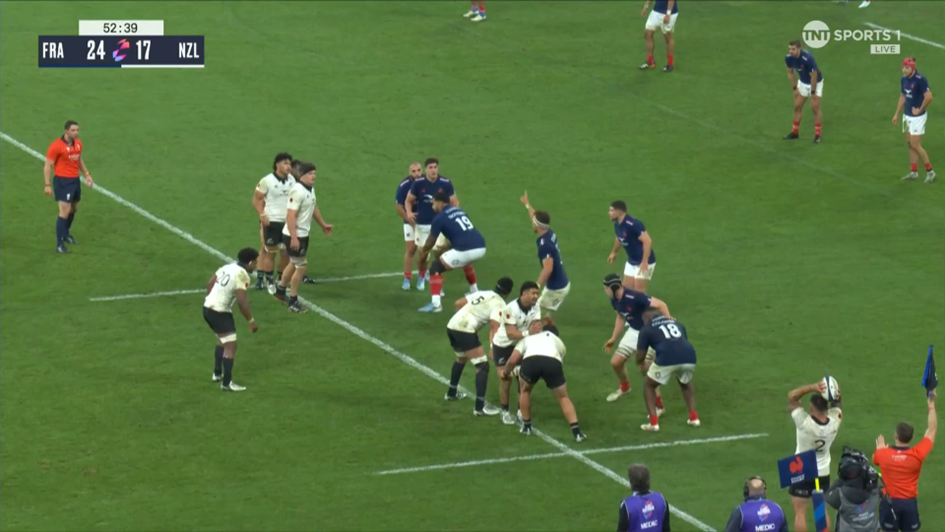
Roumat calling lifters to him after seeing what’s about to happenThe ABs would get another shot at it in the 59th minute, after a breakdown penalty won by Savea. With the gap at seven points, this is the perfect moment to pull out a strike with a high-success rate. The lineout set-up is the same, 6+1, only this time the call is to go to the front. Savea secures the ball and transfers quickly to Lakai, who throws the pass to Ratima. The 9 passes long to ALB who acts in this scenario as the arrow runner. In an interesting variation to the play – which catches the French midfield defence off guard – Lienert-Brown quickly passes to Ioane, who, instead of acting as the dummy inside cut, functions as a sort of secondary arrow, with McKenzie on his shoulder and Barrett as a back-door option.
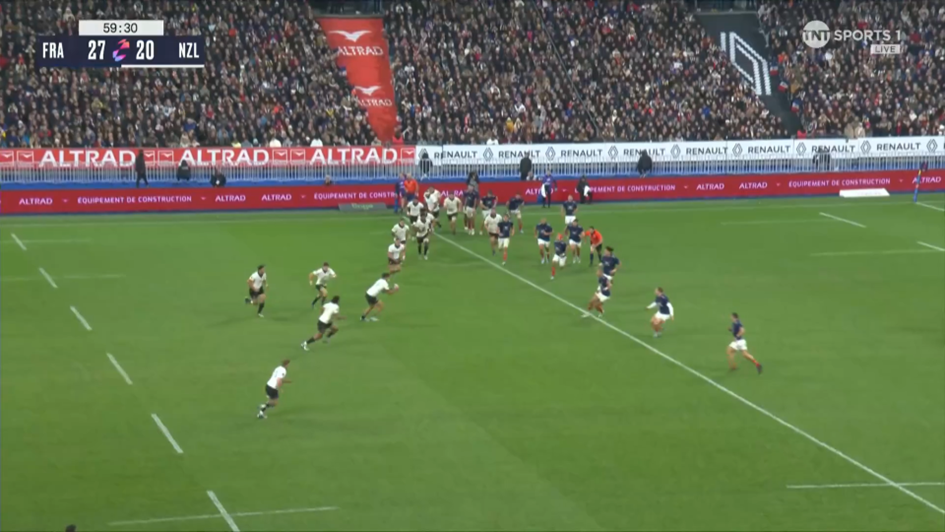
In the standard play, ALB would take up the ball, with Ioane as the dummy runner. Instead, ALB passes to Ioane, creating a secondary arrow.The variation works, as Ramos is caught in no man’s land, allowing Ioane to put McKenzie into space who still has Jordan on the outside.
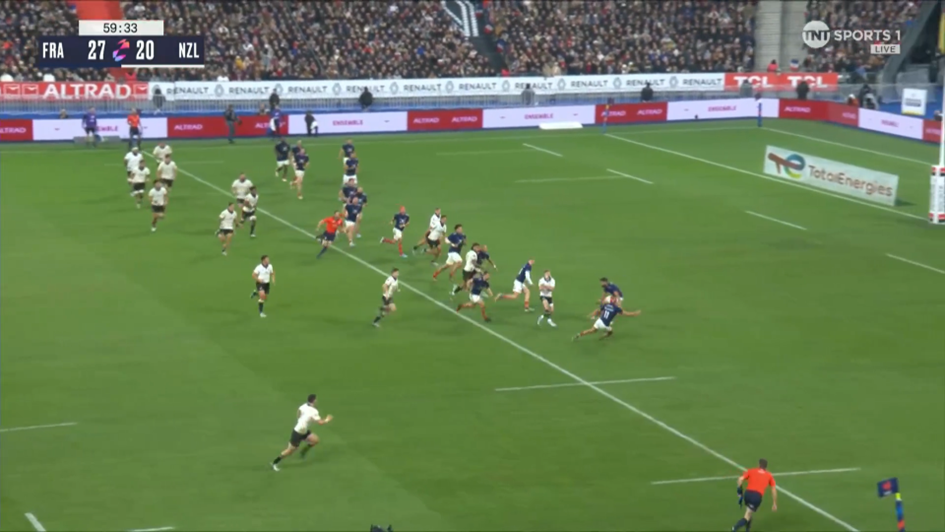
Bielle-Biarrey seems fixed but isn’t.The only thing that saves France is Bielle-Biarrey’s ability to act as two defenders at the same time. First, he is in position to make a tackle-assist on McKenzie but as soon as the latter passes to Jordan, he uses his incredible pace to shut down the space in the corner. Jordan is unable to finish against the French scramble defence and the AB trump card, the Hurricane lineout strike, is successfully foiled.
This is, at least, one good reason why Barrett didn’t go for the corner at the end of the game, as one of the signature strike moves of Holland had been earmarked and recognized by the French defence, both at the lineout (Roumat) and in the scramble (Bielle-Biarrey). If your opposition already knows what is coming, your chances of success drop drastically. Even when the ABs used an unexpected variation to the strike with the secondary arrow, the French defence was still able to adjust quickly.
AB lineout attack in 2024: a mixed bag
Another potential reason for Barrett’s choice is that the NZ set-piece attack has had a season with very mixed results. There were some great tries scored off lineout (SA 1, ENG) and scrum (JP), but other promising movements often fell short through lack of execution. There were also quite a few signs that what worked well in Super Rugby didn’t translate so well to test rugby, including the signature Hurricanes lineout strike.The second game against the Springboks in Cape Town offers some nice examples of this difficult transition, in my view. After creating a lot of opportunities but just coming up short in Joburg, the ABs, once again, were able to produce plenty of line-breaks off lineout attack in Cape Town. In the 13th minute, for example, the ABs have a lineout near the Springbok 22:
Cane breaks off of his position as plus one and Taylor throws it over the top. After a relatively quick recycle, Sititi makes a powerful midfield carry. The Springbok defence is struggling to keep the pace with the AB attack and in the next phase, Ratima passes to Savea who, targeted by both De Allende and Du Toit, passes back inside to Taylor who makes the line-break, as Wiese is too late in taking up his spot on Pieter-Steph’s inside. While this is a nice lineout strike, at the same time, this is the situation immediately after the line-break:

The Springbok defence is more alert to the break than the ABs. Scott Barrett is watching it all unfold and Sititi is only just getting off the floor. While Tamaiti Williams has nicely anticipated the situation, Ratima is the only realistic option to finish the break. Seeing this, Wiese follows the script from the RWC final (run every single support runner off their line, at whatever cost) and clumsily trips up the AB 9, costing himself a trip to the sinbin.
This simple fact – that Test defences react much, much quicker to breaks than Super Rugby defences – has been the single biggest Achilles heel of the 2024 AB lineout attack, as it has been unable to fully anticipate this fact into its strikes. One final example to show this, and where else to finish than with the Hurricane lineout strike.
In the 56th minute, with the ABs trailing the Springboks 13 points to 9, New Zealand has a lineout within the Springbok 22.
The six-man plus one formation is called and, after Barrett secures the ball at the front, Cane acts as the in-field passer to Perenara at 9. Perenara throws a long pass to the arrow runner, ALB, with Jordan running the dummy cut. Lienert-Brown passes out the back to McKenzie, who has Ioane on his shoulder and Reece out wide. McKenzie passes short to Ioane to bypass Kolbe, allowing Rieko to release Reece towards the corner.
Besides the addition of Ioane – which is necessary because of the throw to the front as well as the presence of the Springbok defensive shooter (Kolbe) – this is a mirror image of the typical Hurricane lineout strike. As a result, we can compare some stills side-by-side (I have taken a Hurricanes lineout strike from their game against the Fijian Drua in 2023:
First, the situation of the arrow runner when he is close to the line.
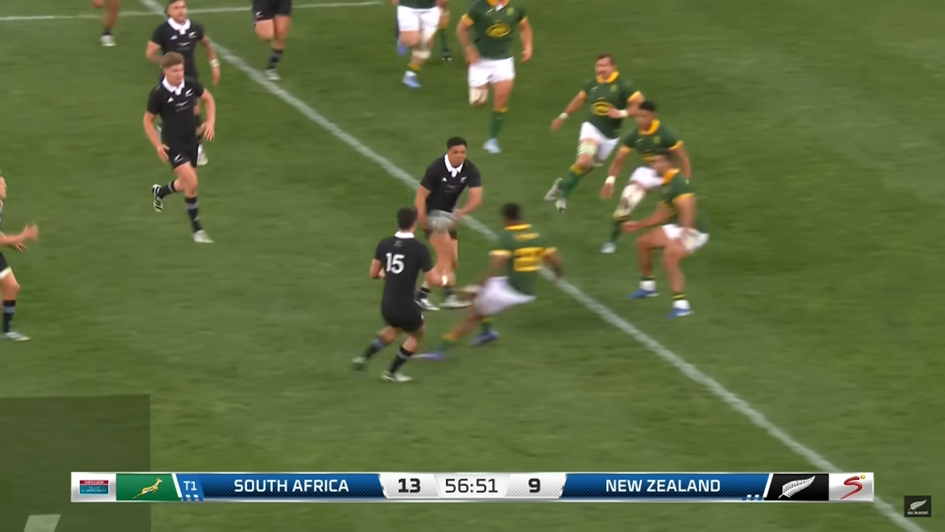
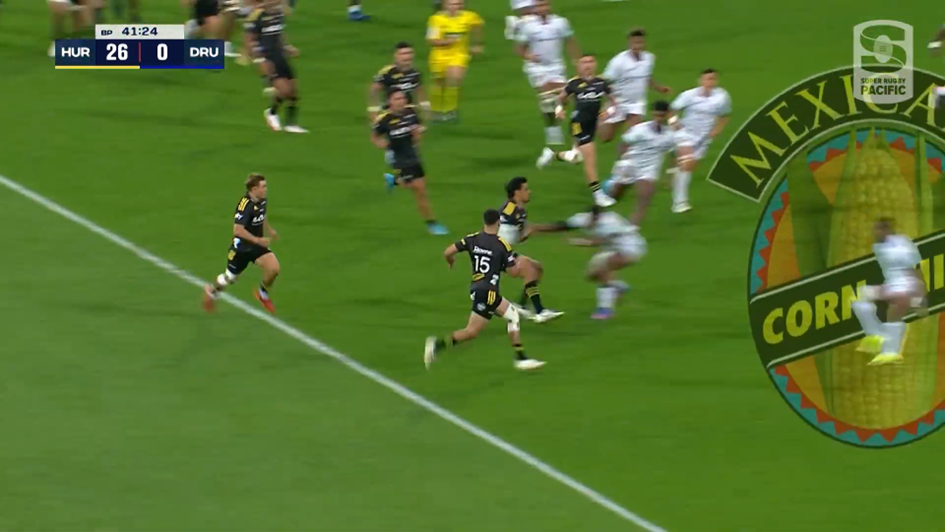
What is noticeable is how different the space off of the arrow runner’s shoulder is in both situations: whereas in the Canes example Moorby is still a solid option for the pop-pass by Sullivan, forcing the Drua edge defender to turn inside, against the Springboks, Am has beaten Jordan into this space. The Jordan dummy run then has no effect on the Springbok scramble to the outside, as they can fully focus on the backdoor options and collectively push to the outside.
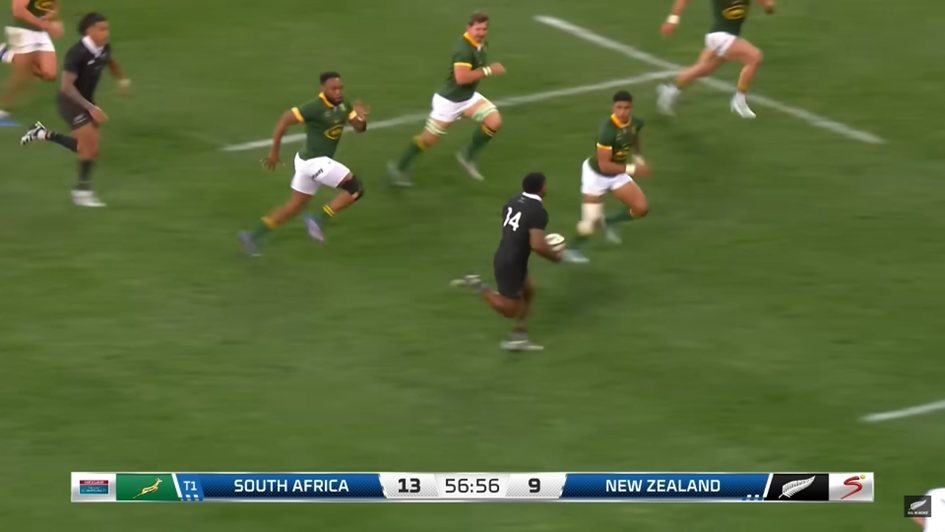

This is the end result of both strikes. Whereas the Fijian Drua defence is comprehensively outflanked by the play, leaving Goosen a simple run-in try, the Springbok defence, on the other hand, has outpaced the AB attack to the corner, leaving Reece face-to-face with four Springbok defenders on their feet. A few aspects have led to this situation: the throw to the front rather than the middle, which means that there is more space to make up; the necessity of McKenzie being a metre further back in order to be able to execute the overlap with Ioane against the Springbok shooting defender (Kolbe); and Jordan being beaten to the space, leaving the scramble defence free to sprint to the outside. These are matters of inches and seconds, but, as it turns out, that is the difference between scoring and getting turned over, between winning and losing.
Returning to the 74th minute in Paris
We will never know what was really going on in Scott Barrett’s head when he pointed to the sticks near the end of the Test match against France. Perhaps he felt they were on the right side of the referee and could eke out a win through Razor’s principles of in-game superiority: defensive intensity, set-piece superiority and dynamic counter-attack phase-play, forcing a penalty in the dying minutes. What we do know, is that he didn’t feel comfortable going to the Hurricane lineout strike as a means of guaranteed points. After being foiled in Cape Town, the French defence had shown itself more than capable of dealing with it as well, both at the lineout and through the scramble, even in the face of clever innovations. If the Hurricane lineout strike is going to return to Test rugby in 2025, Jason Holland will need to find a way of sharpening it, where it can finally cut through South African and French Test defences. If he can, we can expect some of these results to reverse in the next Test season. If he doesn't, Barrett will have to keep going for 3, hoping that this time they can secure an opportunity for the winning kick. -
@Mauss said in All Blacks v France:
When Jason Holland was confirmed as backs coach at the end of 2023, I wasn’t quite as disheartened as many seemingly were on this forum, a feeling especially common amongst Hurricanes fans....
Brilliant, you should do this professionally if you aren't already.
-
@Nevorian said in All Blacks v France:
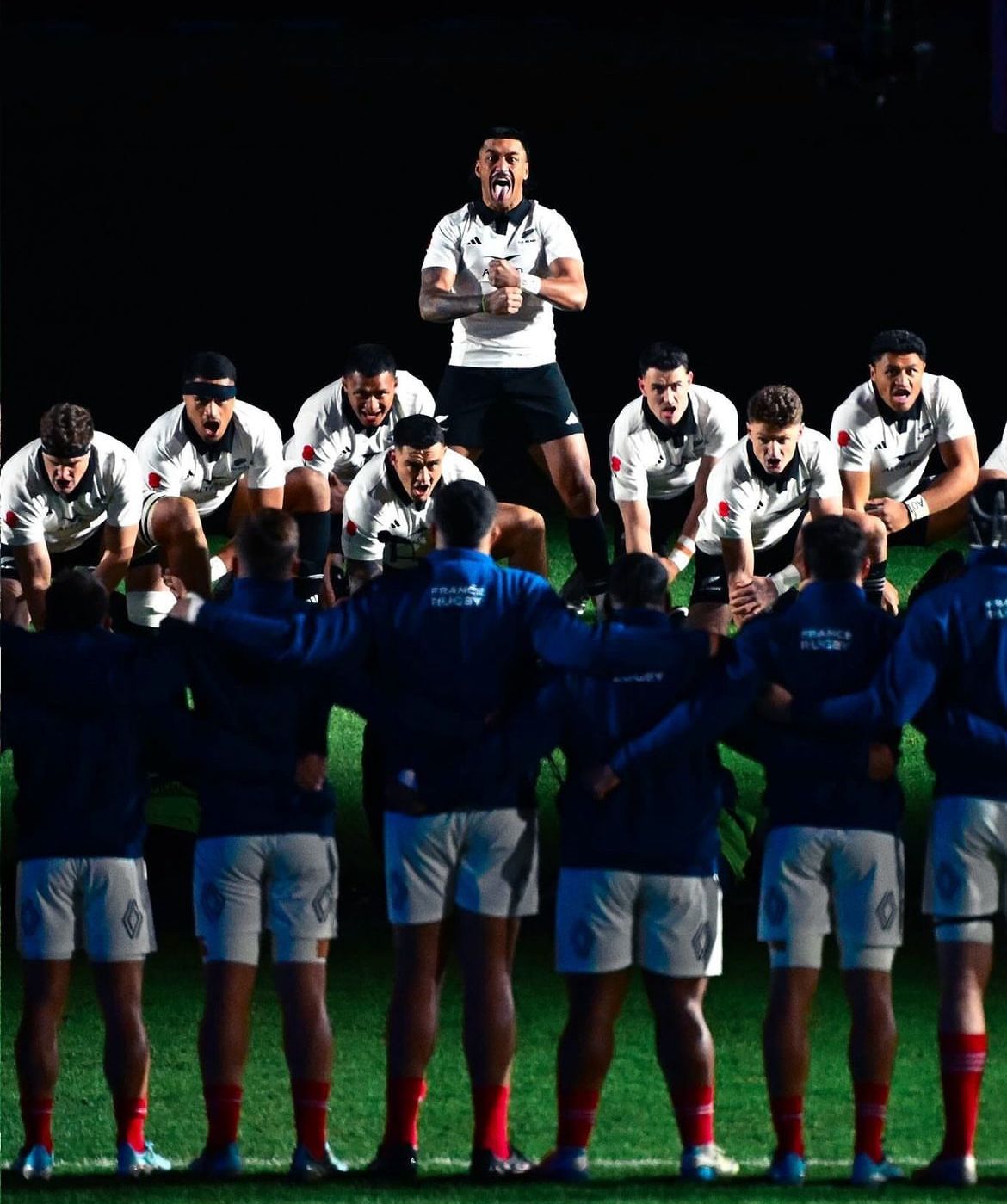
Not sure if this got mentioned earlier in thread but well done to French Rugby for showing some in the Northern Hemisphere still embrace and respect the Haka by literally putting it in the spotlight
Why did Taylor and Rieko lead it together? What was the idea behind that?
-
I’m not saying I agree with the decision because I did find it negative and against the usual allblack mindset,
But I just think scoooter felt in his gut the way the game was going ,
Penalties were more likely and easier to come by than tries
-
@kiwiinmelb said in All Blacks v France:
I’m not saying I agree with the decision because I did find it negative and against the usual allblack mindset,
But I just think scoooter felt in his gut the way the game was going ,
Penalties were more likely and easier to come by than tries
Come back to us with a 2,443 word write-up stating the same, we might consider the theory.
-
@Mauss said in All Blacks v France:
@Kruse To be fair to kiwiinmelb, that's pretty much the gist of it. And you could ask yourself, why write 2,443 words when 47 could suffice?
Then again, I'm personally more of a quantity-over-quality kinda guy.
I love both extremes.
I have heard several times at work somebody reference a "Kruse-style write-up" - meaning an absurd amount of content/explanation/context - informational Shock-and-Awe to prematurely cut off any questions except from idiots.
But also "Kruse-level pith" - usually expressing contempt. -
@Kruse I’m not sure if I’m quite so in control with my responses to things. When watching the game on Saturday, I was curious about the ABs’ use of their lineouts. Next thing you know, I’m watching Hurricanes lineouts from 2022 and looking up how to link timestamps on YouTube videos.
-
sometimes quantity IS quality
-
-
@Mauss said in All Blacks v France:
The variation works, as Ramos is caught in no man’s land, allowing Ioane to put McKenzie into space who still has Jordan on the outside.

Bielle-Biarrey seems fixed but isn’t.The only thing that saves France is Bielle-Biarrey’s ability to act as two defenders at the same time. First, he is in position to make a tackle-assist on McKenzie but as soon as the latter passes to Jordan, he uses his incredible pace to shut down the space in the corner. Jordan is unable to finish against the French scramble defence and the AB trump card, the Hurricane lineout strike, is successfully foiled.
.For me, while I agree I also think if Jordan was more aware he gets into a better position to take that ball flatter (at pace), hence it doesn't have to be thrown so deep and easier for him to beat cover defence. He should have scored if he was good enough in my opinion
-
@mariner4life said in All Blacks v France:
@BerniesCorner said in All Blacks v France:
What was the point in subbing Roigard
I reckon it was fitness. He just doesn't have the miles in the legs to play at that level yet.
There was a play around the 46-47th minute that I thought he missed his assignment. Standard sort of play. Not a reason to get subbed, but I think they knew that short of injury or something else, they wanted/needed 50 solid minutes.
Cortez had more in his tank. He’s had some lessons over the last couple of months. The highs and lows of test footy and playing very well (with little expectation as a NKOTB) to closing out a big test in a hostile atmosphere.
-
@Crazy-Horse said in All Blacks v France:
I think the above is why they are sniffing around Fihaki. He brings some attributes that Stevenson brings, but without the lazy looking brain farts. Don't get me wrong, I don't like the idea of Fihaki in the ABs but I can see the attraction.
I'm not writing him off, but I've just not seen anything to make me think he should be in the frame, apart from having a decent sized err... frame. He looks athletic, but what has he produced?
-
@booboo said in All Blacks v France:
@Crazy-Horse said in All Blacks v France:
I think the above is why they are sniffing around Fihaki. He brings some attributes that Stevenson brings, but without the lazy looking brain farts. Don't get me wrong, I don't like the idea of Fihaki in the ABs but I can see the attraction.
I'm not writing him off, but I've just not seen anything to make me think he should be in the frame, apart from having a decent sized err... frame. He looks athletic, but what has he produced?
He has the tools, is big, has pace, a good punt, and can kick goals.
However, we've yet to really see those at NPC level let alone Super level.
I'm actually a fan but I think this was a terrible selection. -
@bayimports said in All Blacks v France:
@Mauss said in All Blacks v France:
The variation works, as Ramos is caught in no man’s land, allowing Ioane to put McKenzie into space who still has Jordan on the outside.

Bielle-Biarrey seems fixed but isn’t.The only thing that saves France is Bielle-Biarrey’s ability to act as two defenders at the same time. First, he is in position to make a tackle-assist on McKenzie but as soon as the latter passes to Jordan, he uses his incredible pace to shut down the space in the corner. Jordan is unable to finish against the French scramble defence and the AB trump card, the Hurricane lineout strike, is successfully foiled.
.For me, while I agree I also think if Jordan was more aware he gets into a better position to take that ball flatter (at pace), hence it doesn't have to be thrown so deep and easier for him to beat cover defence. He should have scored if he was good enough in my opinion
My first impression was why's he so deep?
-
@bayimports said in All Blacks v France:
For me, while I agree I also think if Jordan was more aware he gets into a better position to take that ball flatter (at pace), hence it doesn't have to be thrown so deep and easier for him to beat cover defence. He should have scored if he was good enough in my opinion
Yeah, he seemed to be a little hesitant to fully commit to the attack. It's like he was watching whether the secondary arrow would work rather than just focussing on his own task.
It's something that reappears quite a lot when looking at AB lineout strikes across the Test season. Just that little lack of detail. In this particular move as well, Ratima is taking Lakai's pass standing still. While the whole point of the strike move is to have the entire backline in movement, so the defence has to take the threat of the running 9 into account as well. That wasn't the case here. It makes it just that little bit easier to defend.